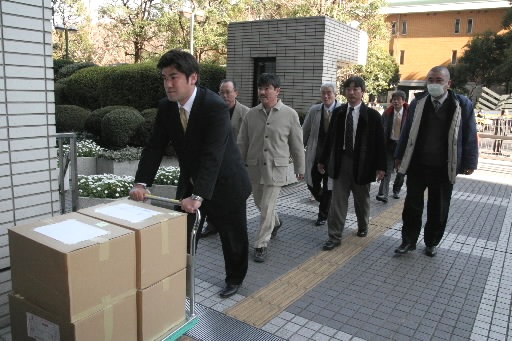Special Series: 60 Years of RERF, Part II [5]
Jun. 30, 2010
Second-generation A-bomb survivors: A nation unmoved
by Masayoshi Ishikawa, Staff Writer
This feature series on the past and future of the Radiation Effects Research Foundation (RERF) originally began to appear in the Chugoku Shimbun in March 2007.
A long way to go to eliminate anxiety
One after another, cardboard boxes were unloaded from a taxi pulled to the curb in Kasumigaseki, Tokyo, the district where the government offices are located. On the afternoon of February 26, 2007, about ten second-generation A-bomb survivors from Hiroshima and Nagasaki brought the signatures of roughly 360,000 people supporting stronger relief measures for second-generation A-bomb survivors into the Ministry of Health, Labour and Welfare (MHLW).
"The worries and sufferings experienced by A-bomb survivors (hibakusha) are being passed along to future generations," said Koji Yamazaki, 38, a resident of the city of Otake and chair of the National Association of Second-generation A-bomb Survivors. His group had called for the signatures to appeal for an improved system of health checkups for second-generation A-bomb survivors and the coverage of their medical expenses. But an official at the MHLW responded: "We would like to wait for the results of the study undertaken by the Radiation Effects Research Foundation (RERF)." The great number of signatures took a year to gather, yet did not receive the regard that had been expected.
Currently, administrative measures geared to the health concerns of second-generation A-bomb survivors are limited. An annual free health checkup for second-generation A-bomb survivors, initiated by the Japanese government in 1979, is a project pursued year-to-year with a research aim. There is no guarantee that the health checkup, which has been repeated every year to date, will be maintained into the future. Measures for second-generation A-bomb survivors were not even included in the Atomic Bomb Survivors Relief Law, established in 1994.
At a news conference held after the signatures were submitted, Mr. Yamazaki spoke out, saying: "Relief measures are needed, as second-generation A-bomb survivors feel uneasy over the fact that the link between our health and the atomic bombings remains uncertain."
The central government, however, takes the very opposite view, contending that "Relief measures are unnecessary, since the link has not been established." Two days after the National Association of Second-generation A-bomb Survivors submitted the signatures of support, RERF released the latest results of its study on the risk of second-generation A-bomb survivors' developing lifestyle-related diseases: "At this stage, no significant difference has been found between second-generation A-bomb survivors and the children of non-hibakusha." Based on this announcement, the General Affairs Division of the Health Service Bureau at the MHLW stated, "We have not obtained new information that would require a change in the current measures."
Meanwhile, some local governments are taking measures of their own beyond the framework of measures adopted by the national government. Topping the local governments which have taken further steps, the Tokyo Metropolitan Government provides cancer screenings and medical allowances for illnesses which require long-term treatment.
The coverage of medical expenses was instituted in 1976. The measure was an innovative step by the Tokyo government, which had pledged "high-quality social services." Efforts in this area were also made by some hibakusha, the parents of second-generation A-bomb survivors.
Nori Tohei, 78, then secretary general of the Tokyo Federation of A-Bomb Sufferers Organizations (Toyukai), cannot forget the meeting of the Tokyo Metropolitan Assembly held in July 1976, where measures for second-generation A-bomb survivors brought debate. One of the assembly members argued, "There is concern over an increase in the budget," then went on to say, "We will be providing relief measures for hibakusha forever. Isn't there some way to eliminate the hibakusha label?"
Mr. Tohei, who experienced the atomic bombing of Hiroshima, spoke at the assembly meeting as a witness. Mr. Tohei's daughter, a second-generation A-bomb survivor, once blamed him for her own fate, saying, "I have your blood in my veins." While appealing for relief measures, Mr. Tohei found himself distressed by the thought of the prejudice and discrimination second-generation survivors must face. As he spoke, his eyes filled with tears.
From this point forward, relief measures for second-generation survivors in Tokyo took root. In fiscal 2005, medical expenses were covered for 345 people and 2,440 people received cancer screenings. The additional outlay borne by the Tokyo Metropolitan Government totaled over 70 million yen. As second-generation A-bomb survivors grow older, their medical expenses naturally tend to increase.
Given these circumstances, local governments across Japan are slow to act and there is no prospect on the horizon of the measures adopted by the Tokyo government spreading nationwide. "It's difficult for people to understand the fear felt by second-generation A-bomb survivors," Mr. Tohei said. "I think relief measures are needed, but we will be facing a problem if the public criticizes us for this assistance." He heaved a deep sigh.
(Originally published on March 26, 2007)








